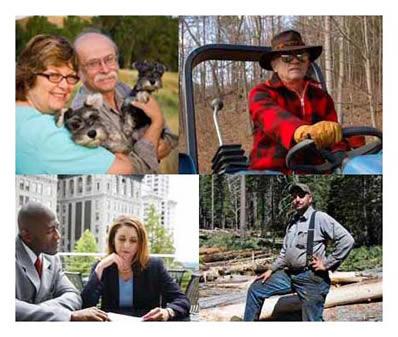
What is social marketing? Why should planners and natural resource managers care? How can data be used to understand landowners?
These are the questions SFFI Project Director Mary Tyrrell and Jerry Greenberg of the American Forest Foundation addressed on July 30th at The Peninsular Florida Landscape Conservation Cooperative’s webinar titled “Using Social Marketing and Micro Targeting to Engage and Move Woodland Owners to Stewardship”.
Across the nation, natural resource professionals are facing a similar challenge: how do we engage woodland owners in priority landscapes and convince them to adopt stewardship-minded behaviors? Past attempts at large scale change have been generally unsuccessful. In fact, there are 3.6 million landowners with 10 acres or more of forestland in the United States, and yet the largest network of woodland owners only encompasses 80,000 owners. The reasons for this failure, according to Greenberg, are twofold: professionals often rely on one-size-fits-all marketing and do not follow-up in a systematic, sustained way.
The duo agreed that managers must recognize how woodland owners’ values and concerns about their land vary across a wide spectrum. Some landowners own forests for beauty and scenery, others for recreation or hunting, and still others for timber or land investment. The US Forest Service National Woodland Owner Survey (NWOS), an annual census of private forest landowners, can help us understand these differences in values, concerns, management activities, and intentions. One key feature of the NWOS, said Tyrrell, is the ability to segment landowners into attitudinal groups based on people’s reasons for owning woodland. This “segmentation” enables managers to use targeted marketing to more effectively communicate with woodland owners.
The premier tool available to natural resource professionals looking to reach woodland owners is TELE (Tools for Engaging Landowners Effectively). The first step in TELE’s social marketing process is to identify what outcomes managers want to see on the land and what actions landowners would need to take to achieve those outcomes. Next, with the help of the NWOS, we can find “prime prospects” or woodland owners who are most likely to change their behavior and/or live in priority landscapes. Social marketing allows us to discover reasons why landowners may not act and then avoid those barriers. Greenberg pointed out that this approach is not only more effective in terms of outcomes, but also saves marketing dollars.
To illustrate, Tyrrell used the example of reaching Woodland Retreat Owners, an NWOS-defined group of people who value the woods for aesthetics, recreation, nature, and biodiversity. Professionals need to frame management in a way that provides value specifically to Woodland Retreat Owners, Tyrrell explained. This might include enhancing wildlife habitat, keeping woodlands healthy and pest-free, or keeping the woodlands intact for future generations. By appealing to a known set of values, we are more likely to see behavior change and in turn, healthier, better protected forests.
Social marketing has already caught on in many networks across the U.S., including the Driftless Forest Network in Wisconsin. This group of state, private, and non-profit organizations has banded together to protect an iconic area of forestland in the Midwest. Thus far 13 landowners have had stewardship plans written, 54 have received cost-share, 8 have enrolled in a tax program, 169 have attended a partner event, and 195 have been visited by a forester. The Network’s end goal is to reach 4,000 acres of oak regeneration by 2016, and with the help of social marketing, they are well on their way to achieving the goal.
Tyrrell and Greenberg emphasized that social marketing tools like TELE are very flexible and have the potential to affect change across landscapes and attitudinal groups. It is up to natural resource professionals to use micro-targeting tools to connect with landowners’ shared values and identify the best ways to keep our forests as forests.
For more information on targeted marketing to landowners, visit the Tools for Engaging Landowners Effectively (TELE) website. To listen to the full webinar or others organized by the US Forest Service National Open Space Conservation Group, click here.